STAIR FALL INJURIES
John T. Thorngren
(10/2/04)
This site sponsored by TEXAND Corporation Home Page
Our son, John T. Thorngren, Jr., passed away on
January 1, 2017. I strongly believe that his
accident on a riserless stairway was a contributing
factor to an early death.
Slips, trips, and falls are responsible for accidental deaths
second only to motor vehicles. According to OSHA, 15 percent of all
accidental deaths come from this source, and nationally, 10 percent of
all injuries. Stair falls account for a large percent of such injuries.
How can a fall down a stairway be fatal? A few broken bones, perhaps,
but fatal? The answer -- unfortunately -- occurs from closed head
injuries and broken necks. If not fatal, star injuries can be quite
debilitating.
Stair falls can be grouped into three categories: 1. Catching
one’s toe between stair steps while ascending (toe-catch), 3. Catching
one’s heel between stair steps while descending (heel-catch), and
3. Other means of tripping or losing one’s balance. This publication
looks at the first two types of stair falls, the toe-catch and the
heel-catch. Three different stair designs in public buildings will be
investigated. All three stairways were made of bone-crushing concrete.
The most dangerous of these designs -- in this author’s opinion -- may
surprise you.
STAIR TERMINOLOGY
 RISER The vertical backing, solid barrier between
successive stair steps (Fig. 1a).
RISERLESS Those designs which are open between stairs
and have no solid, vertical barriers (Fig 1b).
RH The rise or riser height, the vertical
distance between the tops of a successive
stair steps.
RO The open height or open riser height between
successive stairs. Some riserless stairs
have a partial solid riser (Fig. 1c).
RISER The vertical backing, solid barrier between
successive stair steps (Fig. 1a).
RISERLESS Those designs which are open between stairs
and have no solid, vertical barriers (Fig 1b).
RH The rise or riser height, the vertical
distance between the tops of a successive
stair steps.
RO The open height or open riser height between
successive stairs. Some riserless stairs
have a partial solid riser (Fig. 1c).
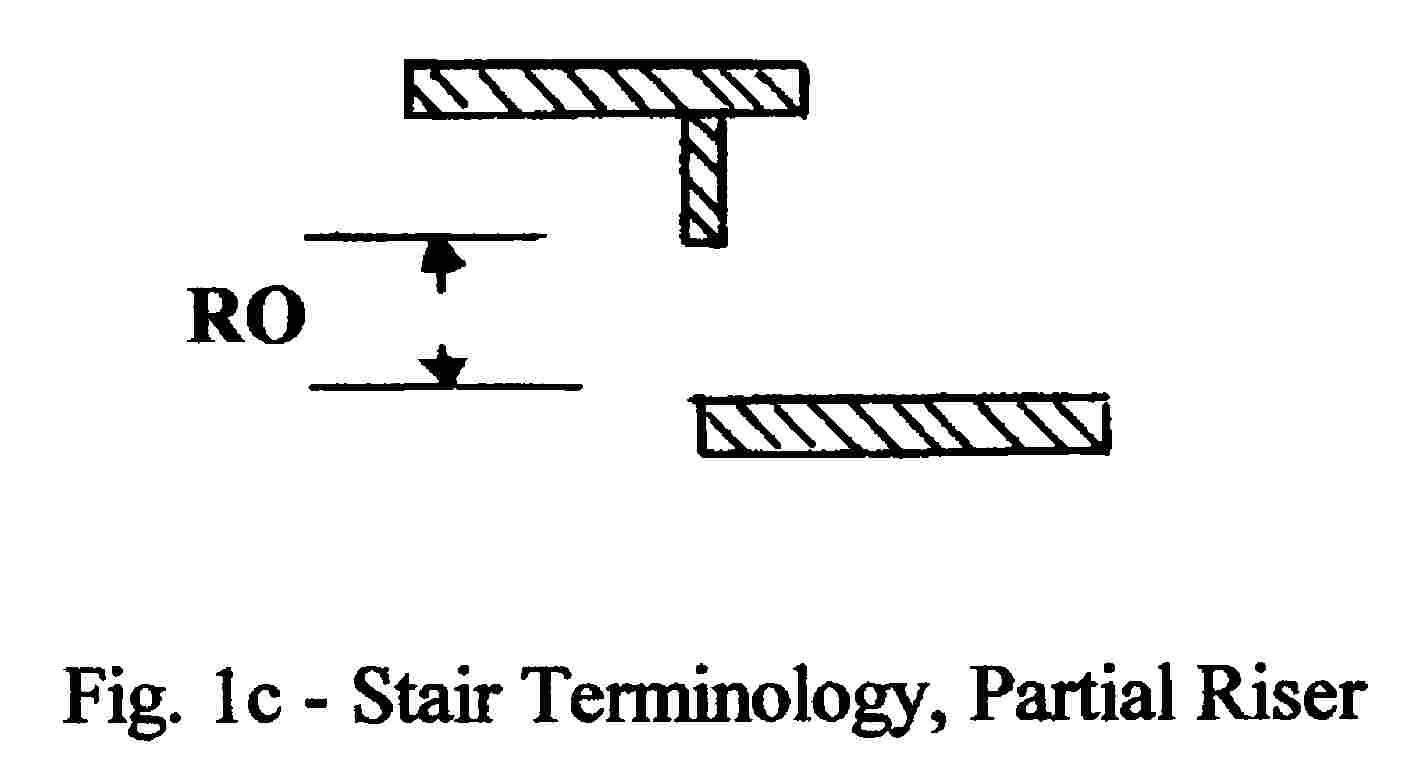 T The thickness of a stair step.
TW The tread width of the stair step measured
from its front tip to its rear. If the stair
has a riser, this distance is measured from
front tip of the stair to the front side of
the riser.
V The overlap distance from the front tip of
a step to the rear end of the next step on
riserless designs, from the front tip of a
step to the front side of the riser on
designs with risers.
RUN TW less V
BUILDING CODES
Local building codes differ but most conform to the
Uniform Building Code(1)(UBC), specifically the 1997
edition. Requirements for stairways are relatively few.
There are no UBC specifics on riserless dimensions.
Those items noted under STAIR TERMINOLOGY are restricted
in public buildings as follows:
RH not less than 4.0 inches nor more than 7.0
inches and the greatest RH shall not exceed
the least on any flight by more than 3/8 inch.
RUN not less than 11.0 inches, of uniform size
and shape except the largest RUN shall not
exceed the least on any flight by more than
3/8 inch.
FOOT TERMINOLOGY
The human foot is shown in Fig. 2 - Foot Terminology.
Subscript "f" on the following items refers to the bare
foot.
T The thickness of a stair step.
TW The tread width of the stair step measured
from its front tip to its rear. If the stair
has a riser, this distance is measured from
front tip of the stair to the front side of
the riser.
V The overlap distance from the front tip of
a step to the rear end of the next step on
riserless designs, from the front tip of a
step to the front side of the riser on
designs with risers.
RUN TW less V
BUILDING CODES
Local building codes differ but most conform to the
Uniform Building Code(1)(UBC), specifically the 1997
edition. Requirements for stairways are relatively few.
There are no UBC specifics on riserless dimensions.
Those items noted under STAIR TERMINOLOGY are restricted
in public buildings as follows:
RH not less than 4.0 inches nor more than 7.0
inches and the greatest RH shall not exceed
the least on any flight by more than 3/8 inch.
RUN not less than 11.0 inches, of uniform size
and shape except the largest RUN shall not
exceed the least on any flight by more than
3/8 inch.
FOOT TERMINOLOGY
The human foot is shown in Fig. 2 - Foot Terminology.
Subscript "f" on the following items refers to the bare
foot.
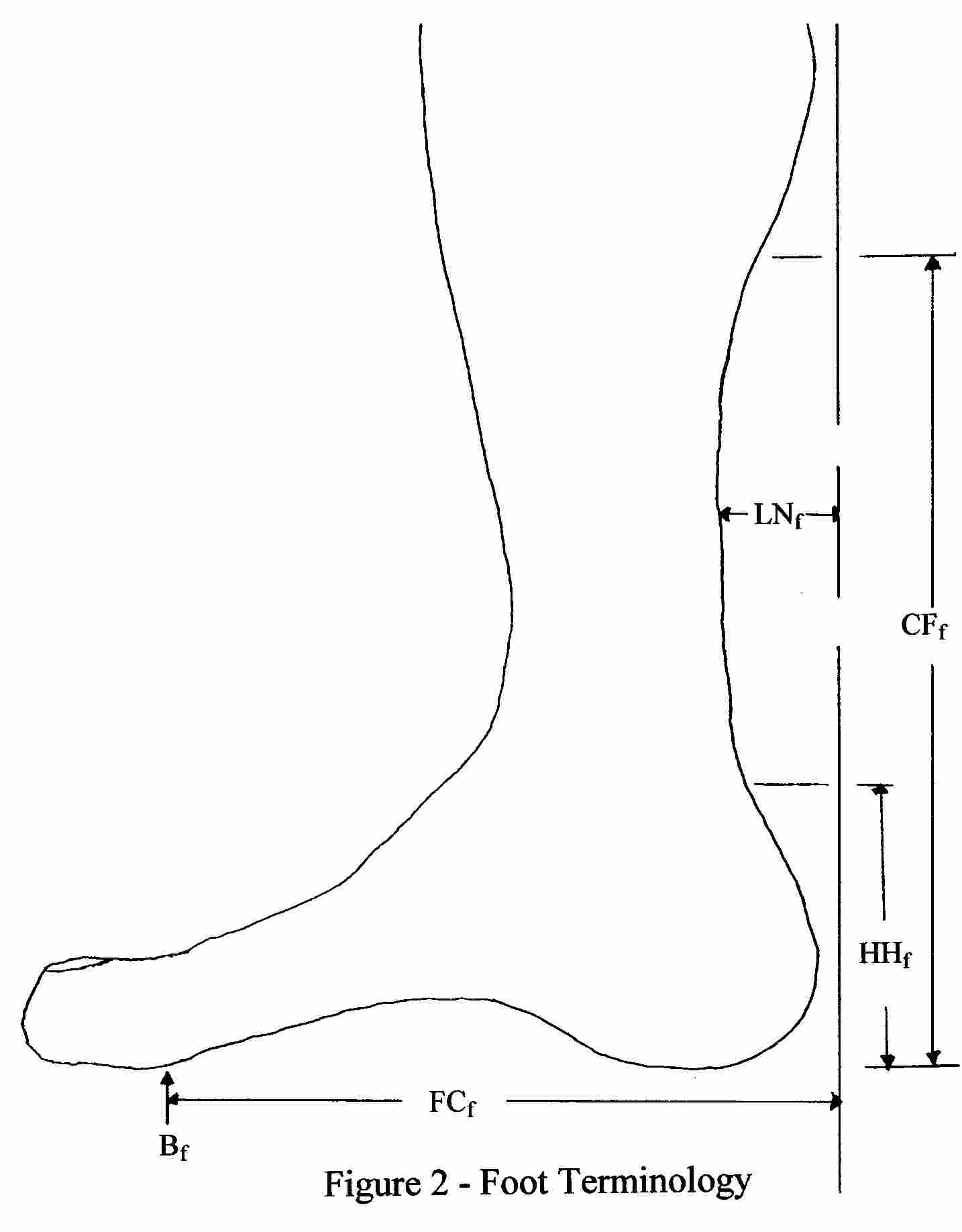 B The ball of the foot, fulcrum point when walking
or stepping down a set of stairs.
FC The fulcrum length measured from the ball to the
back of the heel.
HH The height of the heel measured from its bottom
to the break at the vertical rise of the leg.
CF The height from the bottom of the heel to the
break at the bulge for the calf muscle.
LN The indention measured between the leg and the
vertical line touching the back of the calf and
the heel.
SHOE DESIGN & TERMINOLOGY
A low-heel shoe more or less conforms to the shape of
the bare foot. Low-heel shoes pertain to the male (50 %)
of the population and many female designs and therefore
must represent a major portion of heel-catch injuries.
The shoe is shown as a straight line image in
Fig. 3 - Shoe Terminology.
B The ball of the foot, fulcrum point when walking
or stepping down a set of stairs.
FC The fulcrum length measured from the ball to the
back of the heel.
HH The height of the heel measured from its bottom
to the break at the vertical rise of the leg.
CF The height from the bottom of the heel to the
break at the bulge for the calf muscle.
LN The indention measured between the leg and the
vertical line touching the back of the calf and
the heel.
SHOE DESIGN & TERMINOLOGY
A low-heel shoe more or less conforms to the shape of
the bare foot. Low-heel shoes pertain to the male (50 %)
of the population and many female designs and therefore
must represent a major portion of heel-catch injuries.
The shoe is shown as a straight line image in
Fig. 3 - Shoe Terminology.
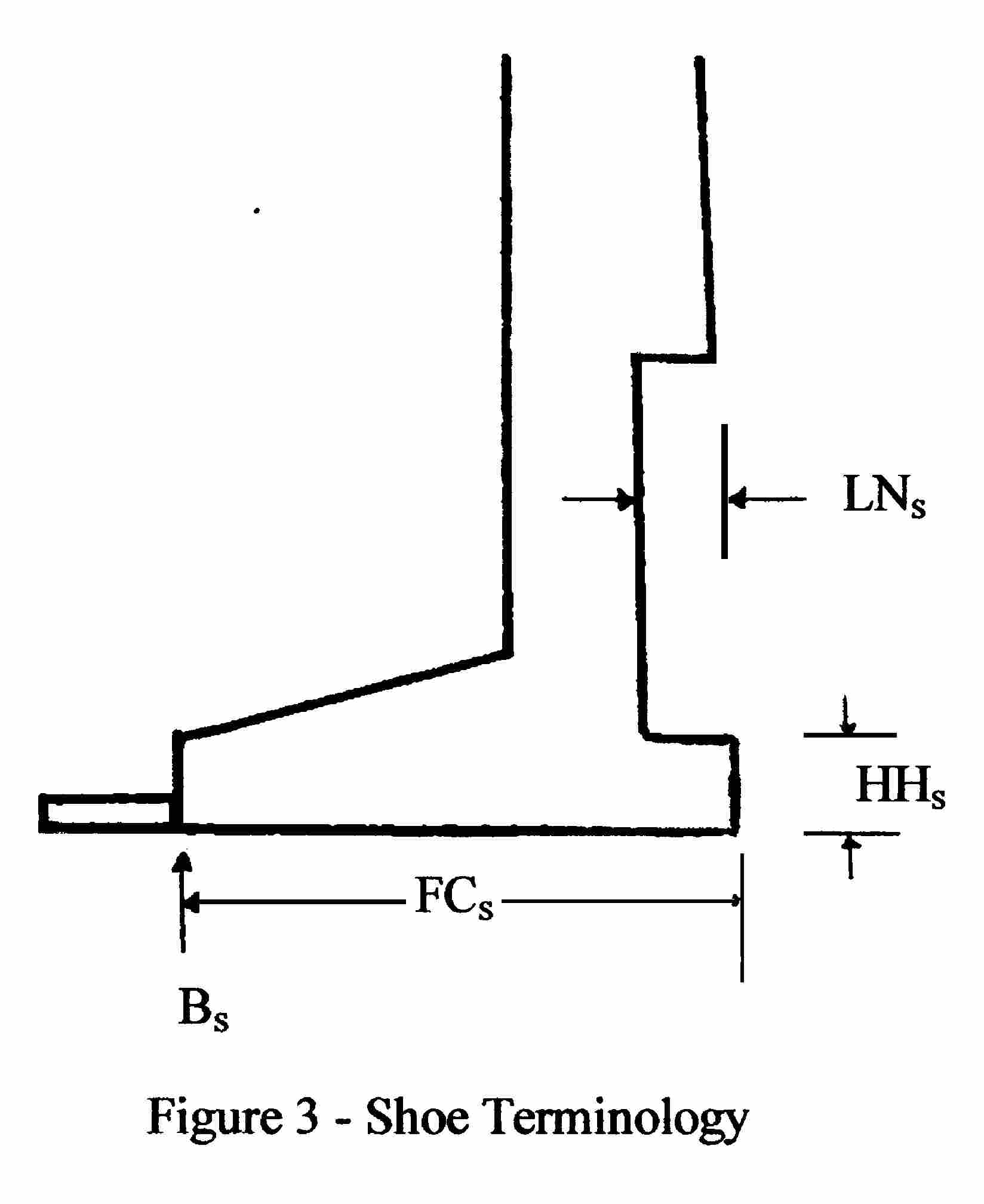 Subscript "s" refers to the same items in the previous
table. Since a low-heel shoe more or less conforms to
the shape of the bare foot, the thickness of the shoe
material increases the dimensions FCf, HHf, LNf and CFf.
An approximate average for items chosen for our "standard"
shoe become:
FCs = 8.0 inches
HHs = 3.25
CFs = 9.25
LNs = 1.5
HEEL-CATCH MODEL
Heel-catch is primarily a riserless stair phenomenon.
Our standard shoe noted previously is superimposed on a
set of riserless stairs. Only the pertinent dimensions are
shown, namely LNs, FCs, and RO.
Subscript "s" refers to the same items in the previous
table. Since a low-heel shoe more or less conforms to
the shape of the bare foot, the thickness of the shoe
material increases the dimensions FCf, HHf, LNf and CFf.
An approximate average for items chosen for our "standard"
shoe become:
FCs = 8.0 inches
HHs = 3.25
CFs = 9.25
LNs = 1.5
HEEL-CATCH MODEL
Heel-catch is primarily a riserless stair phenomenon.
Our standard shoe noted previously is superimposed on a
set of riserless stairs. Only the pertinent dimensions are
shown, namely LNs, FCs, and RO.
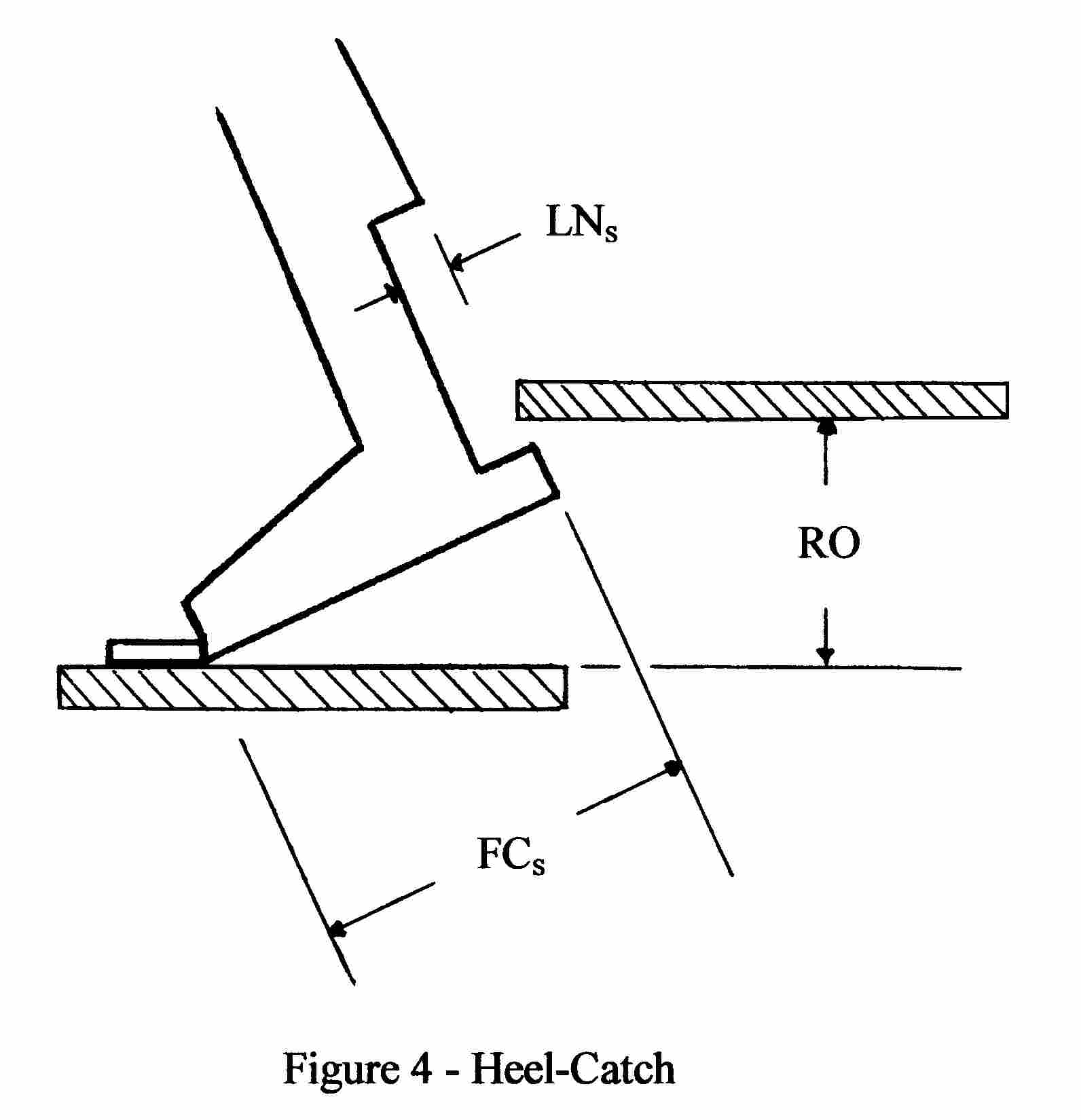 The shoe forms a triangle noted below at which point
the bottom of the heel just catches the underneath front
edge of the step while descending.
The shoe forms a triangle noted below at which point
the bottom of the heel just catches the underneath front
edge of the step while descending.
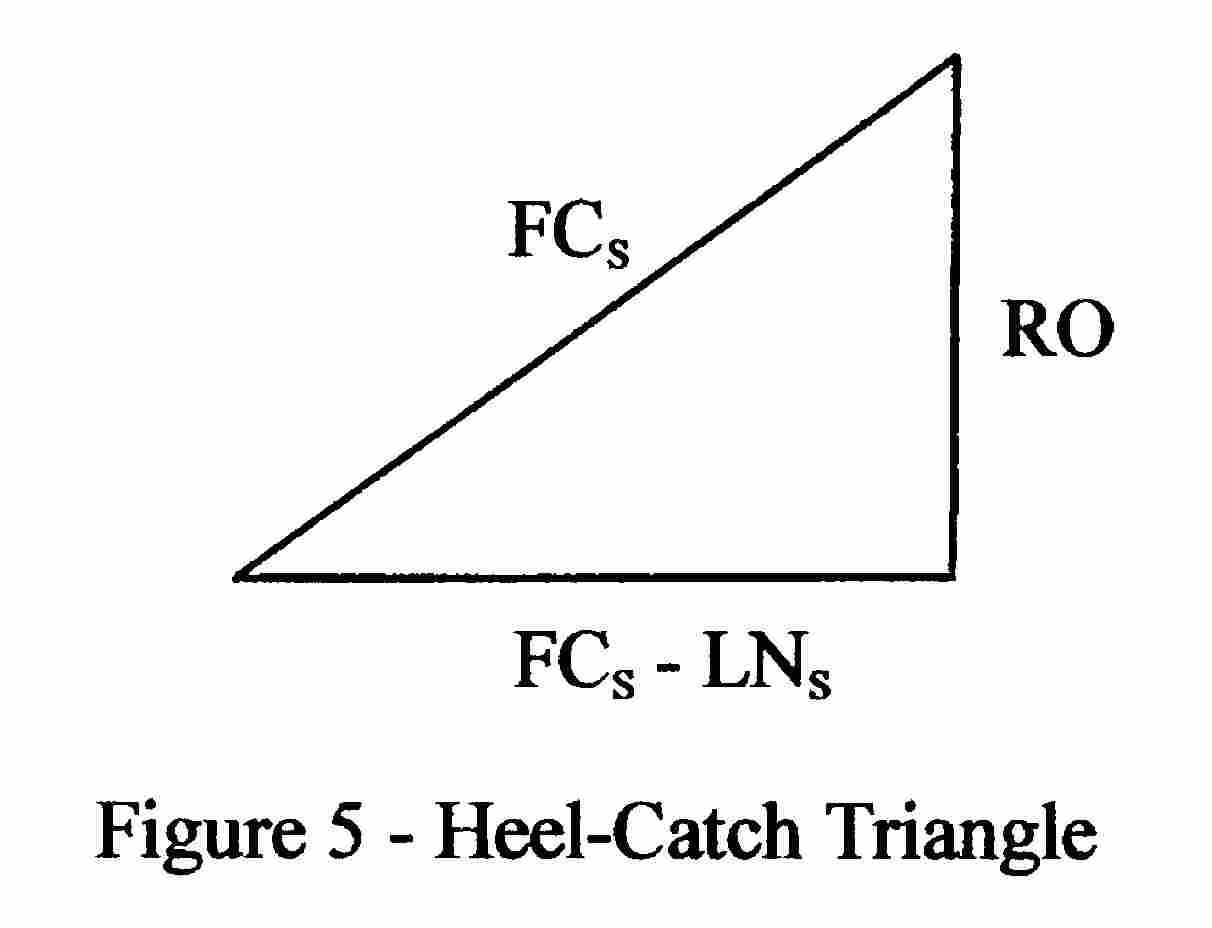 This can be mathematically represented as a
dimensionless heel-catch number HN given by
HN = [(FCs)2 - (RO)2]/[(FCs - LNs)2] (1)
For HN greater than or equal to 1.00, heel-catch is
probable. A general notation form this equation is that
the greater the value of HN (above 1.0), the greater
the probability of injury. This applies down to a
practical point where RO can no longer intercept the
heel.
TOE-CATCH
Toe-catch is also a riserless stair phenomenon.
Toe-catch is probably not as frequent as heel-catch due
to the old cliché, "the nature of the beast": one's
natural gait pulls the foot away from the open riser
area (the jaws of death, so to speak).
Also toe-catch falls while ascending are probably not
as devastating as a heel-catch while descending. The
victim generally can break his fall and stop sliding
farther down the steps. During a heel-catch fall, the
victim frequently tumbles disastrously all the way to
the landing.
STAIR DESIGN NUMBER ONE
This can be mathematically represented as a
dimensionless heel-catch number HN given by
HN = [(FCs)2 - (RO)2]/[(FCs - LNs)2] (1)
For HN greater than or equal to 1.00, heel-catch is
probable. A general notation form this equation is that
the greater the value of HN (above 1.0), the greater
the probability of injury. This applies down to a
practical point where RO can no longer intercept the
heel.
TOE-CATCH
Toe-catch is also a riserless stair phenomenon.
Toe-catch is probably not as frequent as heel-catch due
to the old cliché, "the nature of the beast": one's
natural gait pulls the foot away from the open riser
area (the jaws of death, so to speak).
Also toe-catch falls while ascending are probably not
as devastating as a heel-catch while descending. The
victim generally can break his fall and stop sliding
farther down the steps. During a heel-catch fall, the
victim frequently tumbles disastrously all the way to
the landing.
STAIR DESIGN NUMBER ONE
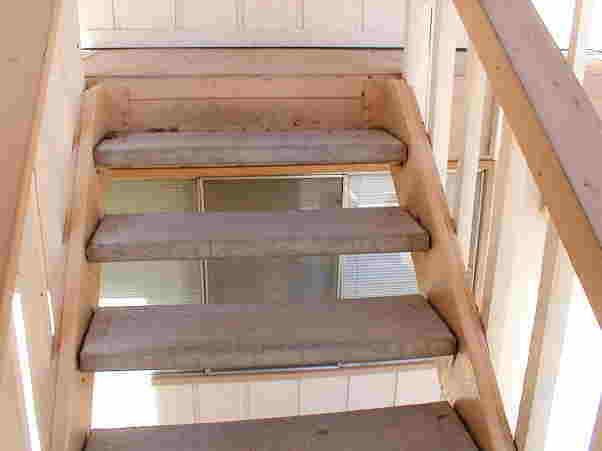 Figure 6 - Design Number One
Theses stairs are riserless and are located in an apartment
complex with the following dimensions in inches:
RH = 8.25 RO = 5.875 V = 1.125
The heel-catch number from Eqn 1 with our standard shoe
becomes
HN = [(8)2 - (5.875)2]/(8 - 1.5)2 = 0.477
Heel-catch is not especially probably with this stairway.
Toe-catch falls are probable.
STAIR DESIGN NUMBER TWO
Figure 6 - Design Number One
Theses stairs are riserless and are located in an apartment
complex with the following dimensions in inches:
RH = 8.25 RO = 5.875 V = 1.125
The heel-catch number from Eqn 1 with our standard shoe
becomes
HN = [(8)2 - (5.875)2]/(8 - 1.5)2 = 0.477
Heel-catch is not especially probably with this stairway.
Toe-catch falls are probable.
STAIR DESIGN NUMBER TWO
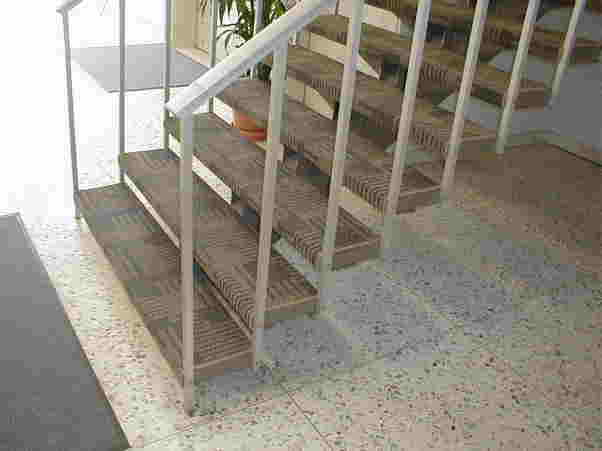 Figure 7 - Design Number Two
These stairs are riserless and located in a commercial
building, They have been carpeted with a thickly woven
fabric, an act which although intended to cushion a fall
actually decreases riser opening, RO, and effective stair
width, RUN. These stairs have the following carpeted
dimensions in inches:
RH = 6.625 RO = 3.875 V = 2.75
The heel-catch number with our standard shoe becomes 1.16
and heel-catch falls are probable. Because of the small RO, toe-catch falls are
more probable for this riserless design than that for Design Number One.
STAIR DESIGN NUMBER THREE
Figure 7 - Design Number Two
These stairs are riserless and located in a commercial
building, They have been carpeted with a thickly woven
fabric, an act which although intended to cushion a fall
actually decreases riser opening, RO, and effective stair
width, RUN. These stairs have the following carpeted
dimensions in inches:
RH = 6.625 RO = 3.875 V = 2.75
The heel-catch number with our standard shoe becomes 1.16
and heel-catch falls are probable. Because of the small RO, toe-catch falls are
more probable for this riserless design than that for Design Number One.
STAIR DESIGN NUMBER THREE
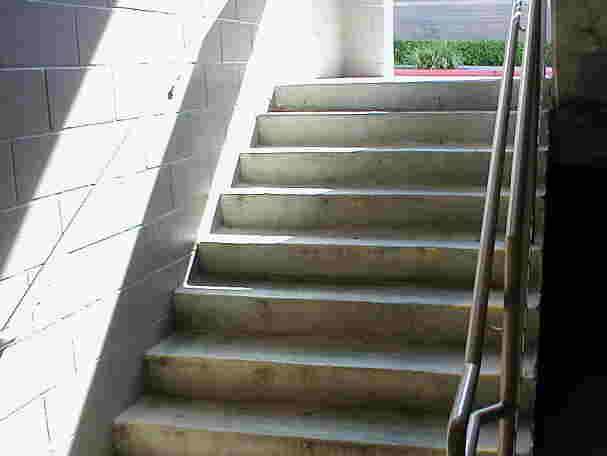 Figure 7 - Design Number Three
These stairs have solid risers and are located in the
parking garage for a hospital well known for treating
and rehabilitating closed head injuries. The probability
of either a heel-catch or toe-catch fall is not remarkable.
With respect to heel-catch and toe-catch injuries, these
are felt to be the safest stairs of all.
CONCLUSION
It is the opinion of the author, a registered
professional engineer in the state of Texas, that
the stair design noted as Stair Design Number Two is
most hazardous. It is further felt that building
codes for public buildings should not allow riserless
stairs on all new construction and should outlaw
and rescind grandfathering of any riserless stair
whose riser opening is less than 5.50 inches.
DEDICATION
This analysis is dedicated to my son, John T.
Thorngren, Jr., who suffered a near fatal accident
on Stair Design Number Two. Our family expresses
their thanks to Parkland Hospital, Dallas, for life
saving measures and to Kindred Hospital, Dallas,
for excellent direction on a long voyage to
rehabilitation.
BIBLIOGRAPHY
1. 1997 UNIFORM BUILDING CODE Vol. 1, International
Conference of Building Officials, 5360 Workman
Mill Rd, Whittier, CA 90601, ISBN 1-884590-87-X,
1997.
Figure 7 - Design Number Three
These stairs have solid risers and are located in the
parking garage for a hospital well known for treating
and rehabilitating closed head injuries. The probability
of either a heel-catch or toe-catch fall is not remarkable.
With respect to heel-catch and toe-catch injuries, these
are felt to be the safest stairs of all.
CONCLUSION
It is the opinion of the author, a registered
professional engineer in the state of Texas, that
the stair design noted as Stair Design Number Two is
most hazardous. It is further felt that building
codes for public buildings should not allow riserless
stairs on all new construction and should outlaw
and rescind grandfathering of any riserless stair
whose riser opening is less than 5.50 inches.
DEDICATION
This analysis is dedicated to my son, John T.
Thorngren, Jr., who suffered a near fatal accident
on Stair Design Number Two. Our family expresses
their thanks to Parkland Hospital, Dallas, for life
saving measures and to Kindred Hospital, Dallas,
for excellent direction on a long voyage to
rehabilitation.
BIBLIOGRAPHY
1. 1997 UNIFORM BUILDING CODE Vol. 1, International
Conference of Building Officials, 5360 Workman
Mill Rd, Whittier, CA 90601, ISBN 1-884590-87-X,
1997.
Author Contact
 RISER The vertical backing, solid barrier between
successive stair steps (Fig. 1a).
RISERLESS Those designs which are open between stairs
and have no solid, vertical barriers (Fig 1b).
RH The rise or riser height, the vertical
distance between the tops of a successive
stair steps.
RO The open height or open riser height between
successive stairs. Some riserless stairs
have a partial solid riser (Fig. 1c).
RISER The vertical backing, solid barrier between
successive stair steps (Fig. 1a).
RISERLESS Those designs which are open between stairs
and have no solid, vertical barriers (Fig 1b).
RH The rise or riser height, the vertical
distance between the tops of a successive
stair steps.
RO The open height or open riser height between
successive stairs. Some riserless stairs
have a partial solid riser (Fig. 1c).
 T The thickness of a stair step.
TW The tread width of the stair step measured
from its front tip to its rear. If the stair
has a riser, this distance is measured from
front tip of the stair to the front side of
the riser.
V The overlap distance from the front tip of
a step to the rear end of the next step on
riserless designs, from the front tip of a
step to the front side of the riser on
designs with risers.
RUN TW less V
BUILDING CODES
Local building codes differ but most conform to the
Uniform Building Code(1)(UBC), specifically the 1997
edition. Requirements for stairways are relatively few.
There are no UBC specifics on riserless dimensions.
Those items noted under STAIR TERMINOLOGY are restricted
in public buildings as follows:
RH not less than 4.0 inches nor more than 7.0
inches and the greatest RH shall not exceed
the least on any flight by more than 3/8 inch.
RUN not less than 11.0 inches, of uniform size
and shape except the largest RUN shall not
exceed the least on any flight by more than
3/8 inch.
FOOT TERMINOLOGY
The human foot is shown in Fig. 2 - Foot Terminology.
Subscript "f" on the following items refers to the bare
foot.
T The thickness of a stair step.
TW The tread width of the stair step measured
from its front tip to its rear. If the stair
has a riser, this distance is measured from
front tip of the stair to the front side of
the riser.
V The overlap distance from the front tip of
a step to the rear end of the next step on
riserless designs, from the front tip of a
step to the front side of the riser on
designs with risers.
RUN TW less V
BUILDING CODES
Local building codes differ but most conform to the
Uniform Building Code(1)(UBC), specifically the 1997
edition. Requirements for stairways are relatively few.
There are no UBC specifics on riserless dimensions.
Those items noted under STAIR TERMINOLOGY are restricted
in public buildings as follows:
RH not less than 4.0 inches nor more than 7.0
inches and the greatest RH shall not exceed
the least on any flight by more than 3/8 inch.
RUN not less than 11.0 inches, of uniform size
and shape except the largest RUN shall not
exceed the least on any flight by more than
3/8 inch.
FOOT TERMINOLOGY
The human foot is shown in Fig. 2 - Foot Terminology.
Subscript "f" on the following items refers to the bare
foot.
 B The ball of the foot, fulcrum point when walking
or stepping down a set of stairs.
FC The fulcrum length measured from the ball to the
back of the heel.
HH The height of the heel measured from its bottom
to the break at the vertical rise of the leg.
CF The height from the bottom of the heel to the
break at the bulge for the calf muscle.
LN The indention measured between the leg and the
vertical line touching the back of the calf and
the heel.
SHOE DESIGN & TERMINOLOGY
A low-heel shoe more or less conforms to the shape of
the bare foot. Low-heel shoes pertain to the male (50 %)
of the population and many female designs and therefore
must represent a major portion of heel-catch injuries.
The shoe is shown as a straight line image in
Fig. 3 - Shoe Terminology.
B The ball of the foot, fulcrum point when walking
or stepping down a set of stairs.
FC The fulcrum length measured from the ball to the
back of the heel.
HH The height of the heel measured from its bottom
to the break at the vertical rise of the leg.
CF The height from the bottom of the heel to the
break at the bulge for the calf muscle.
LN The indention measured between the leg and the
vertical line touching the back of the calf and
the heel.
SHOE DESIGN & TERMINOLOGY
A low-heel shoe more or less conforms to the shape of
the bare foot. Low-heel shoes pertain to the male (50 %)
of the population and many female designs and therefore
must represent a major portion of heel-catch injuries.
The shoe is shown as a straight line image in
Fig. 3 - Shoe Terminology.
 Subscript "s" refers to the same items in the previous
table. Since a low-heel shoe more or less conforms to
the shape of the bare foot, the thickness of the shoe
material increases the dimensions FCf, HHf, LNf and CFf.
An approximate average for items chosen for our "standard"
shoe become:
FCs = 8.0 inches
HHs = 3.25
CFs = 9.25
LNs = 1.5
HEEL-CATCH MODEL
Heel-catch is primarily a riserless stair phenomenon.
Our standard shoe noted previously is superimposed on a
set of riserless stairs. Only the pertinent dimensions are
shown, namely LNs, FCs, and RO.
Subscript "s" refers to the same items in the previous
table. Since a low-heel shoe more or less conforms to
the shape of the bare foot, the thickness of the shoe
material increases the dimensions FCf, HHf, LNf and CFf.
An approximate average for items chosen for our "standard"
shoe become:
FCs = 8.0 inches
HHs = 3.25
CFs = 9.25
LNs = 1.5
HEEL-CATCH MODEL
Heel-catch is primarily a riserless stair phenomenon.
Our standard shoe noted previously is superimposed on a
set of riserless stairs. Only the pertinent dimensions are
shown, namely LNs, FCs, and RO.
 The shoe forms a triangle noted below at which point
the bottom of the heel just catches the underneath front
edge of the step while descending.
The shoe forms a triangle noted below at which point
the bottom of the heel just catches the underneath front
edge of the step while descending.
 This can be mathematically represented as a
dimensionless heel-catch number HN given by
HN = [(FCs)2 - (RO)2]/[(FCs - LNs)2] (1)
For HN greater than or equal to 1.00, heel-catch is
probable. A general notation form this equation is that
the greater the value of HN (above 1.0), the greater
the probability of injury. This applies down to a
practical point where RO can no longer intercept the
heel.
TOE-CATCH
Toe-catch is also a riserless stair phenomenon.
Toe-catch is probably not as frequent as heel-catch due
to the old cliché, "the nature of the beast": one's
natural gait pulls the foot away from the open riser
area (the jaws of death, so to speak).
Also toe-catch falls while ascending are probably not
as devastating as a heel-catch while descending. The
victim generally can break his fall and stop sliding
farther down the steps. During a heel-catch fall, the
victim frequently tumbles disastrously all the way to
the landing.
STAIR DESIGN NUMBER ONE
This can be mathematically represented as a
dimensionless heel-catch number HN given by
HN = [(FCs)2 - (RO)2]/[(FCs - LNs)2] (1)
For HN greater than or equal to 1.00, heel-catch is
probable. A general notation form this equation is that
the greater the value of HN (above 1.0), the greater
the probability of injury. This applies down to a
practical point where RO can no longer intercept the
heel.
TOE-CATCH
Toe-catch is also a riserless stair phenomenon.
Toe-catch is probably not as frequent as heel-catch due
to the old cliché, "the nature of the beast": one's
natural gait pulls the foot away from the open riser
area (the jaws of death, so to speak).
Also toe-catch falls while ascending are probably not
as devastating as a heel-catch while descending. The
victim generally can break his fall and stop sliding
farther down the steps. During a heel-catch fall, the
victim frequently tumbles disastrously all the way to
the landing.
STAIR DESIGN NUMBER ONE
 Figure 6 - Design Number One
Theses stairs are riserless and are located in an apartment
complex with the following dimensions in inches:
RH = 8.25 RO = 5.875 V = 1.125
The heel-catch number from Eqn 1 with our standard shoe
becomes
HN = [(8)2 - (5.875)2]/(8 - 1.5)2 = 0.477
Heel-catch is not especially probably with this stairway.
Toe-catch falls are probable.
STAIR DESIGN NUMBER TWO
Figure 6 - Design Number One
Theses stairs are riserless and are located in an apartment
complex with the following dimensions in inches:
RH = 8.25 RO = 5.875 V = 1.125
The heel-catch number from Eqn 1 with our standard shoe
becomes
HN = [(8)2 - (5.875)2]/(8 - 1.5)2 = 0.477
Heel-catch is not especially probably with this stairway.
Toe-catch falls are probable.
STAIR DESIGN NUMBER TWO
 Figure 7 - Design Number Two
These stairs are riserless and located in a commercial
building, They have been carpeted with a thickly woven
fabric, an act which although intended to cushion a fall
actually decreases riser opening, RO, and effective stair
width, RUN. These stairs have the following carpeted
dimensions in inches:
RH = 6.625 RO = 3.875 V = 2.75
The heel-catch number with our standard shoe becomes 1.16
and heel-catch falls are probable. Because of the small RO, toe-catch falls are
more probable for this riserless design than that for Design Number One.
STAIR DESIGN NUMBER THREE
Figure 7 - Design Number Two
These stairs are riserless and located in a commercial
building, They have been carpeted with a thickly woven
fabric, an act which although intended to cushion a fall
actually decreases riser opening, RO, and effective stair
width, RUN. These stairs have the following carpeted
dimensions in inches:
RH = 6.625 RO = 3.875 V = 2.75
The heel-catch number with our standard shoe becomes 1.16
and heel-catch falls are probable. Because of the small RO, toe-catch falls are
more probable for this riserless design than that for Design Number One.
STAIR DESIGN NUMBER THREE
 Figure 7 - Design Number Three
These stairs have solid risers and are located in the
parking garage for a hospital well known for treating
and rehabilitating closed head injuries. The probability
of either a heel-catch or toe-catch fall is not remarkable.
With respect to heel-catch and toe-catch injuries, these
are felt to be the safest stairs of all.
CONCLUSION
It is the opinion of the author, a registered
professional engineer in the state of Texas, that
the stair design noted as Stair Design Number Two is
most hazardous. It is further felt that building
codes for public buildings should not allow riserless
stairs on all new construction and should outlaw
and rescind grandfathering of any riserless stair
whose riser opening is less than 5.50 inches.
DEDICATION
This analysis is dedicated to my son, John T.
Thorngren, Jr., who suffered a near fatal accident
on Stair Design Number Two. Our family expresses
their thanks to Parkland Hospital, Dallas, for life
saving measures and to Kindred Hospital, Dallas,
for excellent direction on a long voyage to
rehabilitation.
BIBLIOGRAPHY
1. 1997 UNIFORM BUILDING CODE Vol. 1, International
Conference of Building Officials, 5360 Workman
Mill Rd, Whittier, CA 90601, ISBN 1-884590-87-X,
1997.
Figure 7 - Design Number Three
These stairs have solid risers and are located in the
parking garage for a hospital well known for treating
and rehabilitating closed head injuries. The probability
of either a heel-catch or toe-catch fall is not remarkable.
With respect to heel-catch and toe-catch injuries, these
are felt to be the safest stairs of all.
CONCLUSION
It is the opinion of the author, a registered
professional engineer in the state of Texas, that
the stair design noted as Stair Design Number Two is
most hazardous. It is further felt that building
codes for public buildings should not allow riserless
stairs on all new construction and should outlaw
and rescind grandfathering of any riserless stair
whose riser opening is less than 5.50 inches.
DEDICATION
This analysis is dedicated to my son, John T.
Thorngren, Jr., who suffered a near fatal accident
on Stair Design Number Two. Our family expresses
their thanks to Parkland Hospital, Dallas, for life
saving measures and to Kindred Hospital, Dallas,
for excellent direction on a long voyage to
rehabilitation.
BIBLIOGRAPHY
1. 1997 UNIFORM BUILDING CODE Vol. 1, International
Conference of Building Officials, 5360 Workman
Mill Rd, Whittier, CA 90601, ISBN 1-884590-87-X,
1997.